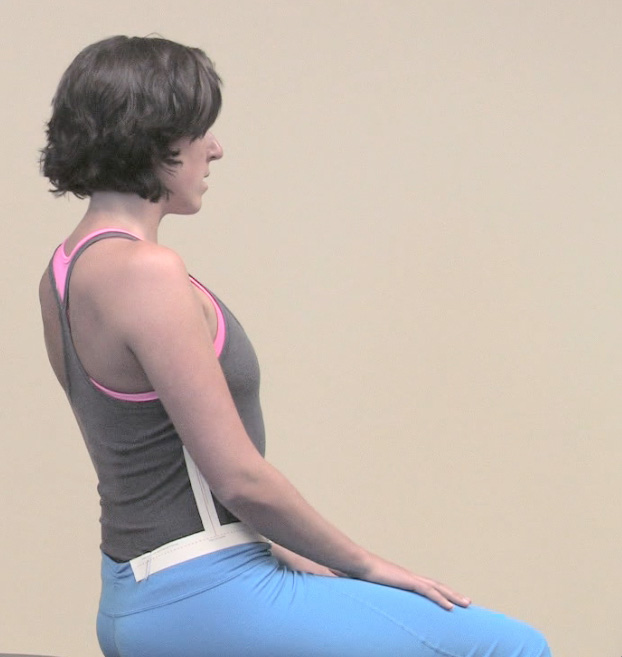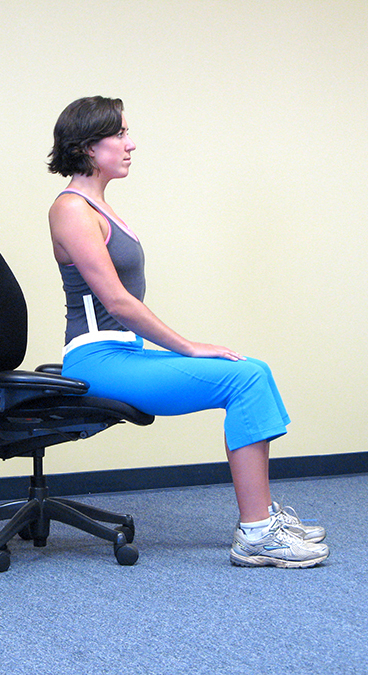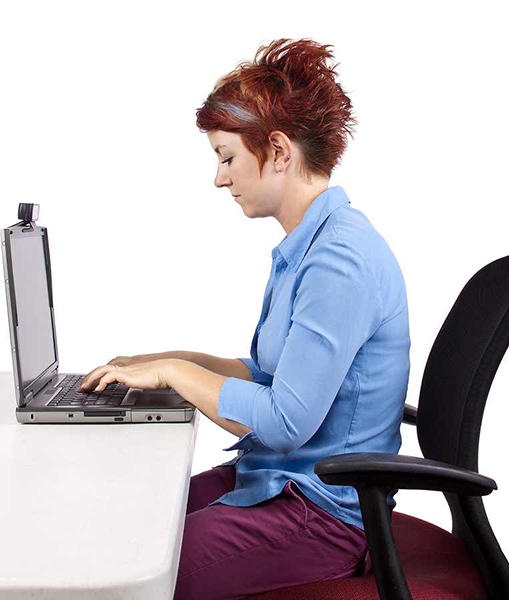The Effect of Gravity Over Time
The big force at work, besides time and money, is gravity. The real test of good seating posture is how easily it can be sustained during the work. When the support muscles for the torso get tired, we lose height. The torso will likely collapse forward, or it may collapse backward. Slumping happens when there is little or no support for the spine, and we can’t sustain ergonomic postures.
Spine Mechanics
Neutral Spine
The general goal is to first get the spine in a position where the space between the joints is greatest, there is the most freedom to move, and the muscles are strongest. That Neutral Spine posture is shown where the head can balance over the hips and spine has the natural curves at the neck and low back.

Neutral Spine Posture in sitting. The pelvis can more easily stabilize the spine when the legs are in their strongest position. The HipIndex is the line at the waist that shows the spine in alignment with the torso.
Reclined posture
How we work may influence body posture more than the chair adjustment. If relaxed work is the only need, then reclined seating is ideal. Chair recline adjustment for back height and angle is important, and stable support is needed. Note that as the back reclines, more neck bend is needed to see forward and down.

Reclined Posture. The body can be relaxed when the chair back can support the torso, and the posture can be sustained for hours.
Slumping is subtle
We slowly get tired of holding the best position when the body doesn’t have support, and the muscles are not fully engaged. When the vision moves down and forward, the head and upper spine follow. When the hips rock back, the spine needs to bend forward to do the work. We use a visual indicator at the pelvis because there is only 20-30 degrees of rotation from the best position to the worst position of the spine. The body collapses when the chair and legs do not fully support the spine from below, and the upper spine is drawn to forward bending by the location of the work surface and the visual targets.
Spinal Collapse
Spinal Collapse shows how the spine bends forward into slumping, either bending at the neck to look down to the keyboard, or leaning forward at the low back when the pelvis rocks backward. Note how the HipIndex points back away from the head, indicating full forward bending of the spine.
Perch Seating
The user may pick a better spine posture, even if the chair does not support that position. The “perched” spine shown here is near the neutral posture for the best strength and movement, and the body is upright to do more forward work. “Perched posture” is preferred in the short term, because the spine position is better, but it takes more effort. There is much less bending at the spine, but there is less support from the chair.

Perched posture may be more comfortable because of better spine position, but there is little support from the chair.
Forward and Mixed Tasks
Mixed tasks on the work surface may be any arm reaching, and looking to the work surface: a calculator, reading or writing brief notes or collating paper. Certainly brief entries to a keyboard will require looking at the keyboard, drawing the head and upper spine forward.
When that work is combined with brief entries to the computer, a stable work surface may be better than using a keyboard tray and arm. The reach distances to the work are shorter, meaning less forward lean, there is more forearm support, and the visual targets require less neck bending.

Many kinds of computer work can be done safely without a keyboard tray, provided the chair and work surface fit the work and the worker
Mixed tasks on the work surface can also include graphic design and heavy mouse use. The shoulders and arms can be more relaxed when fully supported on the work surface, and there is less pressure on the bend of the wrist where the carpal tunnel is located, compared to using a keyboard tray. It is important to consider the strongest leg posture for sitting first, and then locate the height of the work surface to support the shoulder and spine in a healthy posture

Forward tasks require more active muscle work than reclined tasks. If a forward task will be sustained for any length of time, more support will make good postures easier. Here the spine is in good position but will eventually collapse without support.
HipIndex™ Signature Methods of Ergonomic Seating
Moving from relaxed, reclined sitting to upright, forward postures requires increasing amounts of effort and body support. A surprising amount of computer work is done as a forward task. The HipIndex™ Signature method of seating, a good chair and an ergonomic workstation will support the body in good posture for all the work, all day long.



